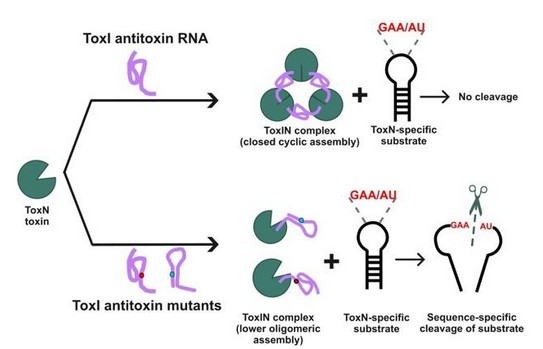Research Summary: We demonstrated that a pseudoknot in antitoxin RNA is crucial for forming closed and inactive toxin–antitoxin complexes. Mutations that disrupt the pseudoknot, hamper complex assembly, leading to toxin activation.
Author Interview

Harshita Dutta is an Integrated Ph.D. student at IISc Bengaluru. Her research focuses on understanding the assembly and function of type III toxin–antitoxin systems for potential antimicrobial applications.
Twitter – https://x.com/Harshita1885
Linkedin – https://www.linkedin.com/in/harshita-dutta-2a7032391/
Instagram – https://www.instagram.com/harshitadutta21/
Lab: Mahavir Singh, Indian Institute of Science, Bangalore
Lab website: https://singhmlab.weebly.com/
What was the core problem you aimed to solve with this research?
We aimed to elucidate the molecular principles governing toxin–antitoxin (TA) complex formation and regulation in type III TA systems. Specifically, we sought to define the functional significance of the conserved antitoxin RNA pseudoknot fold, whose role in toxin neutralization remains unclear.

How did you go about solving this problem?
We designed antitoxin RNA variants carrying single-nucleotide mutations within the pseudoknot region and first examined their inability to rescue bacterial growth under toxin overexpression in E. coli. Mutants that failed to restore growth were analyzed for their thermal stability and structural alterations using UV melting and NMR spectroscopy, respectively. Additionally, we investigated toxin-antitoxin complex formation, toxin binding thermodynamics, and toxin inhibition properties in vitro to assess the impact of pseudoknot disruption on toxin–antitoxin assembly and regulation.
How would you explain your research outcomes (Key findings) to the non-scientific community?
Bacteria have a natural defense system called the toxin–antitoxin systems, which helps them survive viral infections and exposure to antibiotics. Under normal conditions, the toxin remains inactive because it is bound by its antitoxin partner in a stable, closed complex. The antitoxin is an RNA molecule that folds into a special shape known as a pseudoknot, formed by two interconnected hairpins. In our study, we found that this pseudoknot fold is essential for keeping the toxin inactive. When this structure is disrupted, the complex cannot close properly, resulting in active toxin that inhibits bacterial growth.
“We found that a conserved pseudoknot structure in the antitoxin RNA plays a critical role in TA complex formation and toxin neutralization. These findings suggest that disrupting this pseudoknot could serve as a strategy to activate TA systems in pathogenic bacteria, offering a potential antibacterial approach.” – Dr. Mahavir Singh
What are the potential implications of your findings for the field and society?
Our study revealed that the pseudoknot fold in antitoxin is essential for toxin inhibition, and its disruption leads to toxin activation. As activation of bacterial toxin–antitoxin systems is emerging as a promising antimicrobial strategy, our findings suggest that small molecules targeting the pseudoknot fold could be designed to artificially trigger toxin activation, potentially providing a new approach to combat bacterial infections.
What was the exciting moment during your research?
While performing size-exclusion chromatography to examine toxin–antitoxin complex formation, we hypothesized that the antitoxin mutants would fail to form complexes, as they were unable to inhibit the toxin in vivo. As expected, these mutants did not form the closed cyclic assemblies; however, we observed unexpectedly lower-order complexes. This unexpected result was exciting because it opened up new questions about intermediate states and prompted further experiments to gain a deeper understanding of the assembly mechanism.
Paper reference: Dutta H, Manikandan P, Singh M. Role of Antitoxin RNA Pseudoknot in Regulating Toxin Activity and Toxin-antitoxin RNP Complex Assembly. J Mol Biol. 2025 Nov 1;437(21):169410. doi: 10.1016/j.jmb.2025.169410. https://doi.org/10.1016/j.jmb.2025.169410
Explore more
🎤 Career – Real career stories and job profiles of life science professionals. Discover current opportunities for students and researchers.
💼 Jobs – The latest job openings and internship alerts across academia and industry.
🛠️ Services – Regulatory support, patent filing assistance, and career consulting services.




